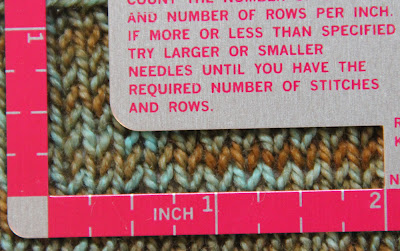A BIG theme that has been coming up lately in my classes, KAL's and personal knitting is GAUGE. If I have one big knitting rule it is:
NEVER SKIP YOUR GAUGE SWATCH! It's tempting, but don't do it! Your hat can come out too small, your sweater too big, OR you could run out of yarn on that gorgeous shawl you are knitting!
The need for this blog post arose as many of my shawl patterns are written for multiple weights of yarn... some astute participants knitting
Trapeze noticed that I stated that to get blocked gauge with a lighter weight yarn one needed to go DOWN a needle size. Frankly, this doesn't make sense, even to me.... how the heck did I come up with that? It stands to reason that a thinner yarn would need a larger needle.
I decided to do an experiment, I knit stockinette stitch samples of fingering and lace weight yarn. First I laid them out flat UNBLOCKED without stretching and measured them:
 |
| Fingering Weight Yarn, Size 5 [3.75 mm] ndl, UNBLOCKED- 11.5 sts/2 inches |
 |
| Lace Weight Yarn, Size 5 [3.75 mm] ndl, UNBLOCKED- 12 sts/2 inches |
So, it would seem that if I wanted to match the gauge of the fingering weight with the lace weight I would need to go
UP a needle size to get the same gauge, right? Going up a needle size would give me
FEWER sts per inch.
But wait, what about blocking? I then soaked both my swatches in warm water, layed them out flat and smooth, and measured again!
 |
| Fingering Weight Yarn, Size 5 [3.75 mm] ndl, BLOCKED- 11 sts/2 inches |
 |
| Lace Weight Yarn, Size 5 [3.75 mm] ndl, BLOCKED- 10 sts/2 inches |
WHAT? Now it seems that to match the gauge of the fingering weight with the lace weight I need to go
DOWN a needle size to get more stitches per inch... the lace weight blocks out much more
OPEN than the fingering weight, what a difference blocking makes!!!!!
Do you know what the moral of this gauge story is? You need to do your OWN gauge swatches when getting ready to work a pattern, your
yarn, your
tension, and your
needles are going to affect
YOUR GAUGE! And the only way to make SURE you are on target is to work it yourself !




I have never washed and blocked my gauge swarchesv-guess I will have to start
ReplyDeleteYES! Gauge is so, so important and absolutely unique to every knitter (and every designer). So many knitters don't understand that each designer gives the gauge that they personally got with the given yarn and needle. Gauges can vary as much from designer to designer as they do for any pair of knitters.
ReplyDeleteVery interesting blog post. I feel like I sound like a broken record when I teach and go on and on about gauge.
ReplyDeleteAre all swatches meant to be blocked to determine proper guage?
ReplyDeleteMost patterns will tell you if your gauge should be blocked or unblocked... if the pattern doesn't say then I assume it should be blocked as they are referring to the finished products gauge which is most likely blocked before being worn!
DeleteThank you so much Laura for this! What a learning curve for me! Lace knitting is so very different for me than regular stockinette stitch knitting which results in close together stitches. Duh! A light bulb has gone on and I realize with all the YO's that it grows a lot when blocked. So, that is why it needs to be a needle size down with lace weight. It never occured to me that blocking out a pattern would make a "BIG" difference in size and gauge! I understand this now!! Big hugs to you Craftsy teacher for helping me see this point! :D
ReplyDeleteYEAH, I am so glad this resonates with you! I knew that it made sense, but doing the swatching experiments to "prove" it was quite the challenge! I adore that we are all learning more about knitting lace together!!!!!
Delete